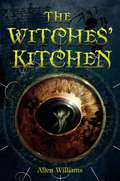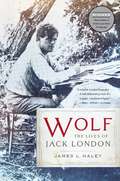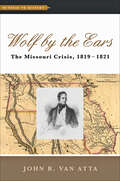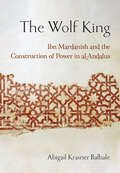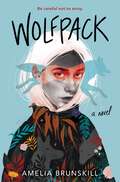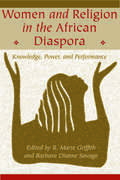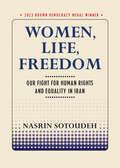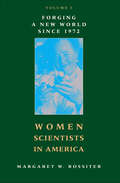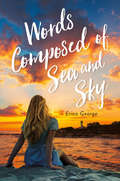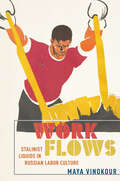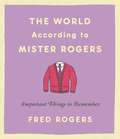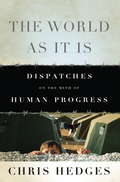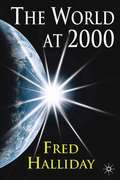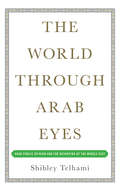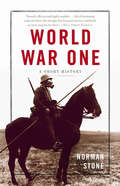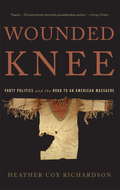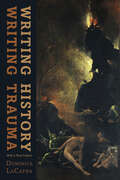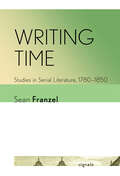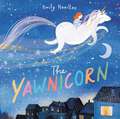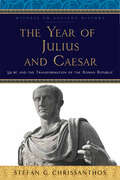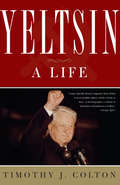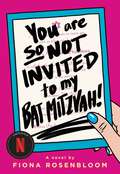- Table View
- List View
The Witches' Kitchen
by Allen WilliamsDeep in the walls of a witches' cottage lays an ancient magical kitchen. Dangling over that kitchen's cauldron, pinched between the fingers of two witches, is a toad. And the Toad has no idea how she got there, and no memory of even her name. All she knows is she doesn't think she was always a Toad, or that she's ever been here before. Determined to recover her memories she sets out on a journey to the oracle, and along the way picks up a rag-tag team of friends: an iron-handed imp, a carnivorous fairy, and a few friendly locals.But the Kitchen won't make it easy. It is pitch black, infinite, and impossible to navigate, a living maze. Hiding in dark corners are beastly, starving things. Worse yet are the Witches themselves, who have sent a procession of horrific, deadly monsters on her trail. With some courage and wisdom, the Toad just might find herself yet-and with that knowledge, the power to defeat the mighty Witches. Filled with forty stunning pencil illustrations from the author, the Witches' Kitchen is a rich, well-imagined fantasy setting unlike any other.
Wolf: The Lives of Jack London
by James L. HaleyJack London was born a working-class, fatherless Californian in 1876. In his youth he was a boundlessly energetic adventurer on the bustling West Coast-by turns playing the role of hobo, sailor, prospector, and oyster pirate. He spent his brief life rapidly accumulating the experiences that would inform his acclaimed, best-selling books: The Call of the Wild, White Fang, and The Sea Wolf. London was plagued by contradictions. He chronicled nature at its most savage, but wept helplessly at the deaths of his favorite animals. At his peak the highest-paid writer in America, he was nevertheless constantly broke. An irrepressibly optimistic crusader for social justice, he burned himself out at forty: sick, angry, and disillusioned, but leaving behind a voluminous literary legacy, much of it ripe for rediscovery. In Wolf, award-winning author James L. Haley explores the forgotten Jack London-at once a hard-living globetrotter and a man alive with ideas, whose passion for social justice roared until the day he died. Returning London to his proper place in the American pantheon, Wolf resurrects a major American novelist in his full fire and glory.
Wolf by the Ears: The Missouri Crisis, 1819–1821 (Witness to History)
by John R. Van AttaFrom the early days of the republic, American leaders knew that an unpredictable time bombâ€�the question of slaveryâ€�lay at the heart of national politics. An implicit understanding between North and South helped to keep the issue at bay: northern states, where slavery had been set on course for extinction via gradual emancipation, tacitly agreed to respect the property rights of southern slaveholders; in return, southerners essentially promised to view slaveholding as a practical evil and look for ways to get rid of it. By 1819–1820, however, westward expansion had brought the matter to a head. As Thomas Jefferson wrote at the time, a nation dealing with the politically implacable issue of slavery essentially held the "wolf" by the earsâ€�and could neither let go nor hang on forever.In Wolf by the Ears, John R. Van Atta discusses how the sectional conflict that led to the Civil War surfaced in the divisive fight over Missouri statehood. The first organized Louisiana Purchase territory to lie completely west of the Mississippi River and northwest of the Ohio, Missouri carried special significance for both pro- and anti-slavery advocates. Northern congressmen leaped out of their seats to object to the proposed expansion of the slave "empire," while slave-state politicians voiced outrage at the northerners’ blatant sectional attack. Although the Missouri confrontation ultimately appeared to end amicably with a famous compromise that the wily Kentuckian Henry Clay helped to cobble together, the passions it unleashed proved vicious, widespread, and long lasting.Van Atta deftly explains how the Missouri crisis revealed the power that slavery had already gained over American nation building. He explores the external social, cultural, and economic forces that gave the confrontation such urgency around the country, as well as the beliefs, assumptions, and fears that characterized both sides of the slavery argument. Wolf by the Ears provides students in American history with an ideal introduction to the Missouri crisis while at the same time offering fresh insights for scholars of the early republic.
The Wolf King: Ibn Mardanish and the Construction of Power in al-Andalus (Medieval Societies, Religions, and Cultures)
by Abigail Krasner BalbaleThe Wolf King explores how political power was conceptualized, constructed, and wielded in twelfth-century al-Andalus, focusing on the eventful reign of Muhammad ibn Sad ibn Ahmad ibn Mardanīsh (r. 1147–1172). Celebrated in Castilian and Latin sources as el rey lobo/rex lupus and denigrated by Almohad and later Arabic sources as irreligious and disloyal to fellow Muslims because he fought the Almohads and served as vassal to the Castilians, Ibn Mardanīsh ruled a kingdom that at its peak constituted nearly half of al-Andalus and served as an important buffer between the Almohads and the Christian kingdoms of Castile and Aragon.Through a close examination of contemporary sources across the region, Abigail Krasner Balbale shows that Ibn Mardanīsh's short-lived dynasty was actually an attempt to integrate al-Andalus more closely with the Islamic East—particularly the Abbasid caliphate. At stake in his battles against the Almohads was the very idea of the caliphate in this period, as well as who could define righteous religious authority. The Wolf King makes effective use of chronicles, chancery documents, poetry, architecture, coinage, and artifacts to uncover how Ibn Mardanīsh adapted language and cultural forms from around the Islamic world to assert and consolidate power—and then tracks how these strategies, and the memory of Ibn Mardanīsh more generally, influenced expressions of kingship in subsequent periods.
Wolfpack
by Amelia BrunskillThis shocking, suspenseful novel about a group of teenage girls living in a cult reveals the terrifying paranoia and suspicion that emerges when one of them goes missing– perfect for fans of We Were Liars. Nine girls bound together in beautiful, virtuous Havenwood, a refuge from an unsafe world. Then there are eight one of them gone — departed with no warning. Did this member of their pack stray willingly, or did something more sinister occur? The girls seek answers not knowing if they should be angry or frightened or perhaps, they should be both.
Women and Religion in the African Diaspora: Knowledge, Power, and Performance (Lived Religions)
by R. Marie GriffithThis landmark collection of newly commissioned essays explores how diverse women of African descent have practiced religion as part of the work of their ordinary and sometimes extraordinary lives. By examining women from North America, the Caribbean, Brazil, and Africa, the contributors identify the patterns that emerge as women, religion, and diaspora intersect, mapping fresh approaches to this emergent field of inquiry.The volume focuses on issues of history, tradition, and the authenticity of African-derived spiritual practices in a variety of contexts, including those where memories of suffering remain fresh and powerful. The contributors discuss matters of power and leadership and of religious expressions outside of institutional settings. The essays study women of Christian denominations, African and Afro-Caribbean traditions, and Islam, addressing their roles as spiritual leaders, artists and musicians, preachers, and participants in bible-study groups. This volume's transnational mixture, along with its use of creative analytical approaches, challenges existing paradigms and summons new models for studying women, religions, and diasporic shiftings across time and space.
Women, Life, Freedom: Our Fight for Human Rights and Equality in Iran (Brown Democracy Medal)
by Nasrin SotoudehThe Laurence and Lynne Brown Democracy Medal, presented by the McCourtney Institute for Democracy at Penn State, recognizes outstanding individuals, groups, and organizations that produce innovations to further democracy in the United States or around the world.Nasrin Sotoudeh is an Iranian lawyer and human rights activist who has been called "Iran's Nelson Mandela." Sotoudeh is a longtime opponent of the death penalty, advocate of improving imprisonment health conditions, and an activist dedicated to fighting for the rights of women, children, religious and ethnic minorities, journalists and artists, and those facing execution. As a result of her advocacy, Sotoudeh has been repeatedly imprisoned by the Iranian government for crimes against the state; she served one sentence from 2010 to 2013 and was sentenced again in 2018 to thirty-eight years and six months in prison and 148 lashes. Her work has been featured in the 2020 documentary Nasrin, by filmmakers Jeff Kaufman and Marcia S. Ross. For this important work, she is the recipient of the 2023 Brown Democracy Medal from the McCourtney Institute for Democracy, marking the award's tenth year.
Women Scientists in America: Forging a New World since 1972 (Women Scientists In America Ser.)
by Margaret W. RossiterThe third volume of Margaret W. Rossiter’s landmark survey of the history of American women scientists focuses on their pioneering efforts and contributions from 1972 to the present. Central to this story are the struggles and successes of women scientists in the era of affirmative action. Scores of previously isolated women scientists were suddenly energized to do things they had rarely, if ever, done before—form organizations and recruit new members, start rosters and projects, put out newsletters, confront authorities, and even fight (and win) lawsuits. Rossiter follows the major activities of these groups in several fields—from engineering to the physical, biological, and social sciences—and their campaigns to raise consciousness, see legislation enforced, lobby for passage of the Equal Rights Amendment, and serve as watchdogs of the media. This comprehensive volume also covers the changing employment circumstances in the federal government, academia, industry, and the nonprofit sector and discusses contemporary battles to increase the number of women members of the National Academy of Science and women presidents of scientific societies. In writing this book, Rossiter mined nearly one hundred previously unexamined archival collections and more than fifty oral histories. With the thoroughness and resourcefulness that characterize the earlier volumes, she recounts the rich history of the courageous and resolute women determined to realize their scientific ambitions.
Words Composed of Sea and Sky
by Erica GeorgeThis modern summer romance set on Cape Cod features two young adult poets divided by centuries. Michaela Dunn, living on present day Cape Cod, dreams of getting into an art school, something her family just doesn't understand. When her stepfather refuses to fund a trip for a poetry workshop, Michaela finds the answer in a local contest searching for a poet to write the dedication plaque for a statue honoring Captain Benjamin Churchill, a whaler who died at sea 100 years ago.She struggles to understand why her town venerates Churchill, an almost mythical figure whose name adorns the school team and various tourist traps. When she discovers the 1862 diary of Leta Townsend, however, she gets a glimpse of Churchill that she didn't quite anticipate. In 1862, Leta Townsend writes poetry under the name Benjamin Churchill, a boy who left for sea to hunt whales. Leta is astonished when Captain Churchill returns after his rumored death. She quickly falls for him. But is she falling for the actual captain or the boy she constructed in her imagination?
Work Flows: Stalinist Liquids in Russian Labor Culture (NIU Series in Slavic, East European, and Eurasian Studies)
by Maya VinokourWork Flows investigates the emergence of "flow" as a crucial metaphor within Russian labor culture since 1870. Maya Vinokour frames concern with fluid channeling as immanent to vertical power structures—whether that verticality derives from the state, as in Stalin's Soviet Union and present-day Russia, or from the proliferation of corporate monopolies, as in the contemporary Anglo-American West. Originating in pre-revolutionary bio-utopianism, the Russian rhetoric of liquids and flow reached an apotheosis during Stalin's First Five-Year Plan and re-emerged in post-Soviet "managed democracy" and Western neoliberalism.The literary, philosophical, and official texts that Work Flows examines give voice to the Stalinist ambition of reforging not merely individual bodies, but space and time themselves. By mobilizing the understudied thematic of fluidity, Vinokour offers insight into the nexus of philosophy, literature, and science that underpinned Stalinism and remains influential today. Work Flows demonstrates that Stalinism is not a historical phenomenon restricted to the period 1922-1953, but a symptom of modernity as it emerged in the twentieth century. Stalinism's legacy extends far beyond the bounds of the former Soviet Union, emerging in seemingly disparate settings like post-Soviet Russia and Silicon Valley.
The World According to Mister Rogers: Important Things to Remember (Charming Petite Ser.)
by Fred RogersA timeless collection of wisdom on love, friendship, respect, individuality, and honesty from the beloved PBS series Mister Rogers' Neighborhood.There are few personalities who evoke such universal feelings of warmth as Fred Rogers. An enduring presence in American homes for over 30 years, his plainspoken wisdom continues to guide and comfort many. The World According to Mister Rogers distills the legacy and singular worldview of this beloved American figure. An inspiring collection of stories, anecdotes, and insights--with sections devoted to love, friendship, respect, individuality, and honesty, The World According to Mister Rogers reminds us that there is much more in life that unites us than divides us.Culled from Fred Rogers' speeches, program transcripts, books, letters, and interviews, along with some of his never-before-published writings, The World According to Mister Rogers is a testament to the legacy of a man who served and continues to serve as a role model to millions.
The World As It Is: Dispatches on the Myth of Human Progress
by Chris HedgesMany liberals are disappointed with Barack Obama. Some talk of "betrayal,” while others are writing abject letters to the White House asking the president to come back to his "true self.” Chris Hedges, however, is a progressive who doesn't feel betrayed. "Obama was and is a brand,” he argues. "He is a product of the Chicago political machine. He has been skillfully packaged by the corporate state.” In his newest book, Hedges argues that the conscious inertia of the left is destroying the progressive movement. Inaction and empty moral posturing leads not to change, but to an orgy of self-adulation and self-pity.Hedges argues that the gravest danger we face as a nation is not from the far right, although the right may well inherit power. Instead, the threat comes from a bankrupt liberal class that has lost the will to fight and the moral courage to stand up for what it espouses.
The World At 2000 (PDF)
by Fred HallidayBeneath the millennial shine of political optimism and technological advance lurk a set of deep uncertainties: global inequality is growing; weapons of mass destruction are spreading; strident assertions of identity divide peoples and states; overall, there is a marked lack of effective co-ordination and reduced confidence in the power of people, ideas and democratic processes to achieve change. This book provides a critical but cautiously optimistic assessment of the state and prospects of the world at 2000. Alternate ISBNs 9780333945353 9780333994276
The World Through Arab Eyes: Arab Public Opinion and the Reshaping of the Middle East
by Shibley TelhamiThe uprisings that transformed the Middle East beginning in 2011 have left experts scrambling to understand where the region is likely to go in years to come. But missing from most of the analysis is a longer view of the evolution of Arab Public opinion and identity and how this is likely to influence this fast-changing region. In The World Through Arab Eyes, Shibley Telhami shows how the roots of these rebellions stretch back decades and explains how they will continue to affect the stability of the Middle East in the years to come. Telhami draws on a decade's worth of polling data and analysis to provide a comprehensive look at this evolution of Arab identity and opinion. The demand for dignity, which was foremost in the chants of millions of Arab demonstrators, went far beyond being a struggle for "food” and individual rights. Telhami identifies the key prisms through which Arabs view issues ranging from democracy and religion to foreign actors, including the United States, European and Asian countries, Iran, Turkey, and, centrally, Israel. These prisms provide a key to interpreting the past, comprehending the seismic changes in Arab politics today, and engaging with the region in the future.
World War One: A Short History
by Norman StoneThe First World War was the overwhelming disaster from which everything else in the twentieth century stemmed. Fourteen million combatants died, four empires were destroyed, and even the victors' empires were fatally damaged. World War I took humanity from the nineteenth century forcibly into the twentieth-and then, at Versailles, cast Europe on the path to World War II as well. In World War One, Norman Stone, one of the world's greatest historians, has achieved the almost impossible task of writing a terse and witty short history of the war. A captivating, brisk narrative, World War One is Stone's masterful effort to make sense of one of the twentieth century's pivotal conflicts.
Wounded Knee: Party Politics and the Road to an American Massacre (Great Plains Photography Ser.)
by Heather Cox RichardsonOn December 29, 1890, American troops opened fire with howitzers on hundreds of unarmed Lakota Sioux men, women, and children near Wounded Knee Creek in South Dakota, killing nearly 300 Sioux. As acclaimed historian Heather Cox Richardson shows in Wounded Knee, the massacre grew out of a set of political forces all too familiar to us today: fierce partisanship, heated political rhetoric, and an irresponsible, profit-driven media.Richardson tells a dramatically new story about the Wounded Knee massacre, revealing that its origins lay not in the West but in the corridors of political power back East. Politicians in Washington, Democrat and Republican alike, sought to set the stage for mass murder by exploiting an age-old political tool-fear. Assiduously researched and beautifully written, Wounded Knee will be the definitive account of an epochal American tragedy.
Wounded Knee: Party Politics and the Road to an American Massacre (Great Plains Photography Ser.)
by Heather Cox RichardsonOn December 29, 1890, American troops opened fire with howitzers on hundreds of unarmed Lakota Sioux men, women, and children near Wounded Knee Creek in South Dakota, killing nearly 300 Sioux. As acclaimed historian Heather Cox Richardson shows in Wounded Knee, the massacre grew out of a set of political forces all too familiar to us today: fierce partisanship, heated political rhetoric, and an irresponsible, profit-driven media. Richardson tells a dramatically new story about the Wounded Knee massacre, revealing that its origins lay not in the West but in the corridors of political power back East. Politicians in Washington, Democrat and Republican alike, sought to set the stage for mass murder by exploiting an age-old political tool -- fear. Assiduously researched and beautifully written, Wounded Knee will be the definitive account of an epochal American tragedy.
Writing History, Writing Trauma (Parallax: Re-visions of Culture and Society)
by Dominick LaCapraTrauma and its aftermath pose acute problems for historical representation and understanding. In Writing History, Writing Trauma, Dominick LaCapra critically analyzes attempts by theorists and literary critics to come to terms with trauma and with the crucial role post-traumatic testimonies—notably Holocaust testimonies—assume in thought and in writing. These attempts are addressed in a series of six interlocking essays that adapt psychoanalytic concepts to historical analysis, while employing sociocultural and political critique to elucidate trauma and its aftereffects in culture and in people. This updated edition includes a substantive new preface that reconsiders some of the issues raised in the book.
Writing History, Writing Trauma (Parallax: Re-visions of Culture and Society)
by Dominick LaCapraTrauma and its aftermath pose acute problems for historical representation and understanding. In Writing History, Writing Trauma, Dominick LaCapra critically analyzes attempts by theorists and literary critics to come to terms with trauma and with the crucial role post-traumatic testimonies�notably Holocaust testimonies�assume in thought and in writing. These attempts are addressed in a series of six interlocking essays that adapt psychoanalytic concepts to historical analysis, while employing sociocultural and political critique to elucidate trauma and its aftereffects in culture and in people. This updated edition includes a substantive new preface that reconsiders some of the issues raised in the book.
Writing Time: Studies in Serial Literature, 1780–1850 (Signale: Modern German Letters, Cultures, and Thought)
by Sean FranzelWriting Time shows how serial literature based in journals and anthologies shaped the awareness of time at a transformative moment in the European literary and political landscapes. Sean Franzel explores how German-speaking authors and editors "write time" both by writing about time and by mapping time itself through specific literary formats.Through case studies of such writers as F. J. Bertuch, K. A. Böttinger, J. W. Goethe, Ludwig Börne, and Heinrich Heine, Franzel analyzes how serial writing predicated on open-ended continuation becomes a privileged mode of social commentary and literary entertainment and provides readers with an ongoing "history" of the present, or Zeitgeschichte. Drawing from media theory and periodical studies as well as from Reinhart Koselleck's work on processes of temporalization and "untimely" models of historical time, Writing Time presents "smaller" literary forms—the urban tableau, cultural reportage, and caricature—as new ways of imagining temporal unfolding, recentering periodicals and other serial forms at the heart of nineteenth-century print culture.
The Yawnicorn
by Emily HamiltonMagic is waiting in this rhythmic, calming tale that is the perfect bedtime story for when little ones struggle to fall asleep!You're tucked into bed, ready for sleep. But . . . your head is all busy. and your legs are all twitchy. And this blanket is so itchy!It's time to call on the Yawnicorn! Tuck in for an enchanting nighttime adventure flying over oceans, marching through jungles, and soaring across glittering galaxies until you find your perfect dreamland. With the Yawnicorn's help, young readers are destined for a night of magical wonder and sweet dreams.Join the Yawnicorn on a bedtime adventure you'll never forget!
The Year of Julius and Caesar: 59 BC and the Transformation of the Roman Republic (Witness to Ancient History)
by Stefan G. ChrissanthosThe year 59 BC—when Gaius Julius Caesar and Marcus Calpurnius Bibulus served as joint consuls—marked a major turning point in the history of the Roman Republic. It was a dramatic and momentous time of political intrigue, bloodshed, and murder, one that boasted some of the most famous personalities ever to grace the Roman historical stage. Arguing that this pivotal year demands extended study, Stefan G. Chrissanthos's The Year of Julius and Caesar is the first focused investigation of the period.Chrissanthos uses a single event as his centerpiece: the violent attack orchestrated by Caesar and the "First Triumvirate" on Bibulus and his followers in the Forum on April 4. Before that day, he reveals, 59 had been a typical year, one that provides valuable insight into Roman government and political gamesmanship. But the assault on Bibulus changed everything: the consul retired to his house for the rest of the year, allowing Caesar and his allies to pass legislation that eventually enabled Caesar to take complete control of the Roman state. This detailed reconstruction draws on archeological and literary evidence to describe a watershed year in the history of the late Roman Republic, establish an accurate chronology, and answer many of the important historical questions surrounding the year 59. Written in an engaging and accessible style, The Year of Julius and Caesar will appeal to undergraduates and scholars alike and to anyone interested in contemporary politics, owing to the parallels between the Roman and American Republics.
The Year of Julius and Caesar: 59 BC and the Transformation of the Roman Republic (Witness to Ancient History)
by Stefan G. ChrissanthosThe year 59 BC—when Gaius Julius Caesar and Marcus Calpurnius Bibulus served as joint consuls—marked a major turning point in the history of the Roman Republic. It was a dramatic and momentous time of political intrigue, bloodshed, and murder, one that boasted some of the most famous personalities ever to grace the Roman historical stage. Arguing that this pivotal year demands extended study, Stefan G. Chrissanthos's The Year of Julius and Caesar is the first focused investigation of the period.Chrissanthos uses a single event as his centerpiece: the violent attack orchestrated by Caesar and the "First Triumvirate" on Bibulus and his followers in the Forum on April 4. Before that day, he reveals, 59 had been a typical year, one that provides valuable insight into Roman government and political gamesmanship. But the assault on Bibulus changed everything: the consul retired to his house for the rest of the year, allowing Caesar and his allies to pass legislation that eventually enabled Caesar to take complete control of the Roman state. This detailed reconstruction draws on archeological and literary evidence to describe a watershed year in the history of the late Roman Republic, establish an accurate chronology, and answer many of the important historical questions surrounding the year 59. Written in an engaging and accessible style, The Year of Julius and Caesar will appeal to undergraduates and scholars alike and to anyone interested in contemporary politics, owing to the parallels between the Roman and American Republics.
Yeltsin: A Life
by Timothy J. ColtonEven after his death in April 2007, Boris Yeltsin remains the most controversial figure in recent Russian history. Although Mikhail Gorbachev presided over the decline of the Communist party and the withdrawal of Soviet control over eastern Europe, it was Yeltsin-Russia's first elected president-who buried the Soviet Union itself. Upon taking office, Yeltsin quickly embarked on a sweeping makeover of newly democratic Russia, beginning with a program of excruciatingly painful market reforms that earned him wide acclaim in the West and deep recrimination from many Russian citizens. In this, the first biography of Yeltsin's entire life, Soviet scholar Timothy Colton traces Yeltsin's development from a peasant boy in the Urals to a Communist party apparatchik, and then ultimately to a nemesis of the Soviet order. Based on unprecedented interviews with Yeltsin himself as well as scores of other Soviet officials, journalists, and businessmen, Colton explains how and why Yeltsin broke with single-party rule and launched his drive to replace it with democracy. Yeltsin's colossal attempt to bring democracy to Russia remains one of the great, unfinished stories of our time. As anti-Western policies and rhetoric resurface in Putin's increasingly bellicose Russia, Yeltsin offers essential insights into the past, present, and future of this vast and troubled nation.
You Are So Not Invited to My Bat Mitzvah!
by Fiona RosenbloomSoon to be a Netflix film featuring Adam Sandler! Stacy Friedman is getting ready for one of the most important events of her young life - her bat mitzvah. All she wants is the perfect dress to wear, her friends by her side, and her biggest crush ever, Andy Goldfarb, to dance with her (and maybe even make out with her on the dance floor). But Stacy's well-laid plans quickly start to fall apart... Her stressed-out mother forces her to buy a hideous sequined dress that makes her look like the bride of Frankenstein. Her mitzvahs are not going well at all. And then the worst thing in the entire world happens causing Stacy to utter the words that will wreak complete havoc on her social life: You are SO not invited to my bat mitzvah!
